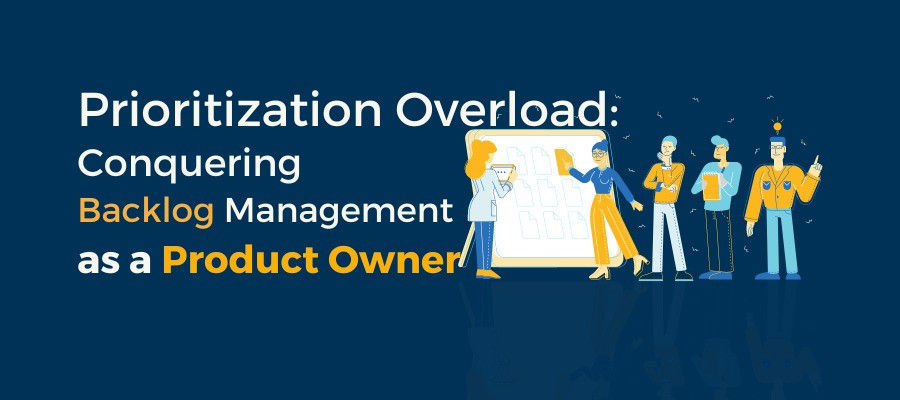Prioritization Overload: Conquering Backlog Management as a Product Owner

Ever feel overwhelmed by the sheer volume of tasks awaiting in your Product Backlog? Managing and prioritizing an extensive Product Backlog can often feel like a Herculean task for a Product Owner. Yet, effective backlog management is crucial for the success of your Agile projects. That’s why PremierAgile brings you the ultimate guide to conquer your backlog management responsibilities!
Why Is Managing Product Backlog So Important?
Backlog management is more than maintaining a list of tasks. It involves continuous refinement and prioritization to ensure the team always works on the most valuable User Stories and Product Backlog Items (PBIs). However, the Certified Scrum Product Owner (CSPO) often faces various challenges in managing the Product Backlog!
The Challenges Of Backlog Management:
- Volume of Tasks: The sheer number of tasks can be daunting. With new ideas, feature requests, and bug reports constantly flowing in, keeping track of everything requires diligence and an effective system.
- Changing Priorities: Business priorities and market conditions can change rapidly. Staying agile and adjusting the Product Backlog accordingly without confusion or delays is a significant challenge.
- Stakeholder Expectations: Balancing the demands and expectations of multiple stakeholders can complicate prioritization. Each stakeholder may have different views on what is most important, leading to potential conflicts.
However, if you can overcome these challenges with a well-managed Product Backlog, you can quickly drive your Agile Team toward the Product Vision you had initially. You can align your commitments with the business goals and customer needs!
Conquering Backlog Management: Techniques and Strategies
Now you know why managing Product Backlog is an important step toward achieving the end Product Goal, it’s time to review the best techniques you can use within your team!
Define A Clear Product Vision and Goals:
Start by defining a clear Product Vision outlining the upcoming Sprint Goals. The Product Roadmap is a guiding star, helping you select which PBI to prioritize and when. Align the backlog with the product goals to ensure every item contributes to the overarching vision.
Prioritize Using Proven Frameworks:
Several prioritization frameworks can help you manage the Product Backlog effectively:
- MoSCoW Method: The MoSCoW method categorizes tasks into four groups: must-have, Should-Have, Could-Have, and Won’t-Have. Must-haves are essential for project success. Should-haves add significant value but are not critical. Could-haves are desirable but can be omitted if necessary. Won’t-haves are the lowest priority and can be reconsidered for future releases.
- RICE Scoring: RICE (Reach, Impact, Confidence, Effort) helps make objective prioritization decisions. Reach estimates the number of people affected by the task. Impact assesses the potential contribution to overall goals. Confidence evaluates how sure you are about the Reach and Impact estimates. Effort measures the time required to complete the task. The formula (Reach * Impact * Confidence) / Effort helps prioritize tasks with higher scores.
- Kano Model: The Kano Model categorizes features into Basic, Performance, and Excitement Needs. Primary Needs are essential for avoiding user dissatisfaction. Performance Needs to improve satisfaction proportionally as they are delivered. Excitement Needs to delight users but is not expected. This model helps prioritize features that significantly enhance customer satisfaction and product success.
Perform Continuous Backlog Refinement:
Make Backlog Refinement an ongoing process. Regularly review and update the Product Backlog to ensure it remains relevant and prioritized. This will keep the team aligned and reduce the risk of working on outdated or low-value tasks.
Limit Work in Progress (WIP):
Implementing WIP limits is crucial for maintaining team focus and efficiency. By restricting the number of tasks the team can work on simultaneously, WIP limits prevent the dilution of effort across too many tasks. This approach ensures the team concentrates on completing current tasks before starting new ones. WIP limits help reduce context switching, minimize multitasking, and enhance workflow stability, leading to faster and more predictable delivery times.
Apply The Pareto Principle:
The Pareto Principle, also known as the 80/20 rule, is a powerful tool for prioritization. 80% of the value is often delivered by 20% of the tasks. Applying this principle helps Product Owners identify and focus on high-impact tasks that will generate the most significant value. By prioritizing these critical tasks, teams can maximize efficiency and effectiveness, ensuring that the most valuable work is completed first, ultimately leading to more successful project outcomes.
Implement Feedback Loops:
Incorporate regular feedback loops from users and stakeholders. Use this feedback to adjust priorities and ensure the product evolves in line with user needs and market trends. Sprint Reviews and Retrospectives are excellent opportunities for gathering feedback.
It’s Time To Take An Action!
Are you ready to take control of your Product Backlog and lead your team to success? Effective backlog management is vital to successful Agile project delivery. You can conquer prioritization overload by defining a clear vision, using proven prioritization frameworks, and continuously refining the Product Backlog. Also, try to use the techniques discussed in the guide and implement them in your team!
Reference:
https://www.scrum.org/resources/blog/prioritization-techniques-product-owner
https://www.atlassian.com/agile/product-management/prioritization-framework



